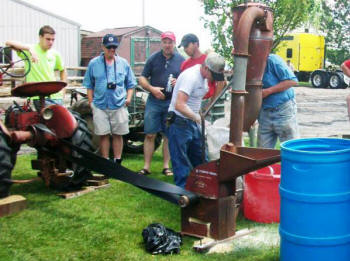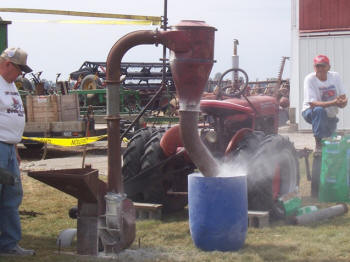|
One of the neatest implements offered by McCormick-Deering was the Model 4e Hammer Mill. This model grinds grain using several different screen sizes ranging from 1/16 – 7/8 inch diameter holes. Using a screen with 1/16” holes produces flour like result from any ground grain. Cracking corn for chicken feed would require a screen with bigger holes and so on. The size screen you need depends on what you intend to do with your grain.
Farmers with a small livestock or poultry population found these hammer mills to be very useful to have around. They could produce their own feed from their crops with out having to haul their goods to a commercial mill. This also allowed them to produce the grain as needed so they did not have to store large quantities. With a Model 4e the farmer could grind approximately 3,500 pounds of shelled corn and hour or nearly 2,900 pounds of eared corn. Naturally this mill is not limited to corn only, other grains can be milled also. This versatile accessory played an important part in keeping a farmers livestock fed. These mills are easily powered by the Cub’s PTO drive via a four inch belt using an angle drive. The mill can also be operated using a 3-7˝ hp electric motor. Depending on the type of discharge chute installed the farmer could attach feed sacks or simply load a grain wagon. Additional attachments allowed the farmer to extend the height of the chute as needed. Assembly of different configurations is quite easy and can be achieved by one person, but two people make it a lot easier. I never knew these existed until I saw one advertised for sale on Farmallcub.com. After asking a few questions and doing a little internet searching for information on these I decided to buy it. It was located over 450 miles away in Georgia. Shipping would be very cost ineffective. I knew the seller from our Cub group so I asked if I could leave it there until I could get it as long as I paid in advance. Ron said he had no problem with that so I bought it. My intention was to pick it up when I was there several months later for his CubFest.
Not long after I bought it my daughter was mowing grass. she came in and said somebody had pulled in the drive and stood at the gate watching her for a bit and then left. She said she saw he left something near our maple tree. I went out to see what was going on and found the mill sitting under the tree. Another member of Farmallcub.com who lived in central Ohio had gone to Georgia to visit his family. While there he stopped and picked up my mill and dropped it off as he was passing through. That sure made things convenient for me. We hauled the mill to Grand Rapids, Ohio for the Ohio CubFest to put on a demonstration. I bought ten bushel of corn with the intention of grinding into feed for the hosts chickens. Once the mill was assembled we fired up the Cub that powered it to give it a try. Almost immediately the old leather belt gave way. We drove into town and found a Tractor Supply store and located the belting and splices needed to make a new belt. After we had it going we started loading it with corn. The four or five people who had gathered to watch us assemble the mill quickly grew to almost thirty when they heard the corn grinding. Currently, I only have a 3/16" screen. This produces a fine mix that is suitable for chickens. A bigger screen such as 1/4" may be a better choice for that purpose. I will be looking for the material needed to fabricate several size screens for future use. Eventually I would like to add a screen to allow whole, ear corn to be ground also.
In October, 2010 I set the mill up to give demonstrations at Central Indiana CubFest. It drew a lot of lookers and quite a few in attendance had questions and said they had never seen anything like it behind a Cub. Bud Sottong, the host of CI CubFest donated a half wagon load of corn for use during the demonstration. He noted how having only the one screen size made a fine grain and suggested trying to operate it with the screen removed. The result was a mix that consisted of fine up to a cracked corn. This combination presented what appeared to be a better feed corn.
Click here for the 4-e Hammermill Manual
|



